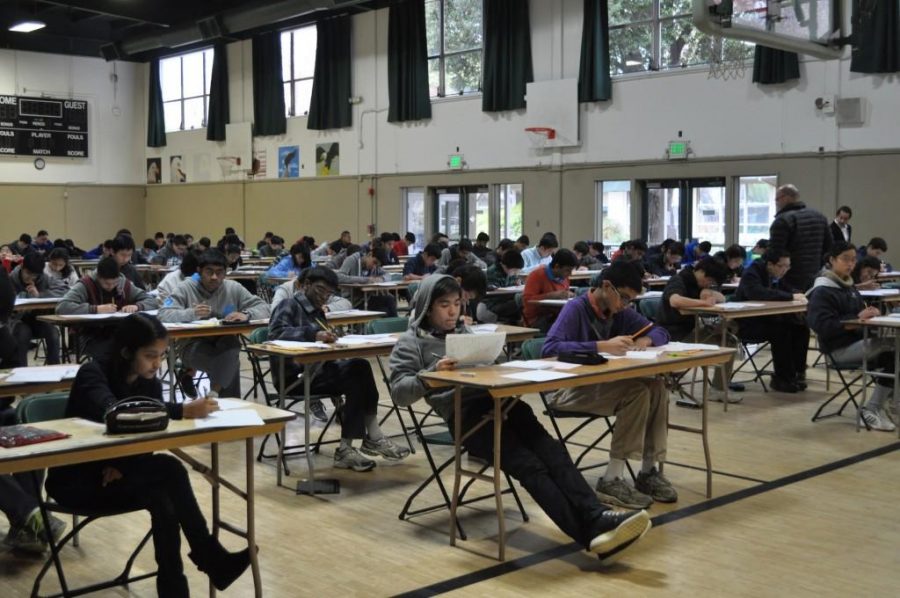Students participate in annual AMC 10 and 12 exams
Students complete the 2014 AMC 10 and 12 exams. The tests are administered annually on campus in February; while the 2014 exams were taken in the gymnasium, this year’s exams were taken in Nichols Atrium.
February 7, 2017
More than 110 upper school students competed in the American Mathematics Competition (AMC) 10 or 12, sitting the 75-minute exam this morning at 8 a.m. in Nichols Atrium.
Every year, more than 350,000 students from 6,000 schools nationwide partake in the AMC competitions. The history and objective of the AMC competition has been the same for over 60 years: to increase the math capabilities of America’s youth through the vehicle of tests which are geared to challenge students and induce mathematical thinking.
“I think definitely where as the diverse selection of math courses Harker provides allows me to pique my interests in various fields, the challenging nature of the problems that demand you to apply the concepts you learn in the classroom to create elegant solutions to solve the problems [is] unique,” Jimmy Lin (11), who took the AMC 12, said.
The competition altered Tuesday’s schedule, with school officially beginning at 9:35 a.m., giving those who are not taking the tests a break from an 8 a.m. start.
While it is recommended that takers of the AMC 10 and 12 have taken geometry, participants in the contest are not excluded based on any particular high-level math course.
“In my opinion, the AMC 10 and 12 exams would be a good start for anyone who is looking to begin participating in math competitions,” Math Club advisor Dr. Anuradha Aiyer said. “There are other competitions that the Math Club runs that may not be as intense as the AMC, but certainly a lot of the problems at the beginning [of the contest] are very approachable.”
If a student excels on the AMC test, they have the opportunity to advance into the American Invitational Math Examination (AIME), a competition which determines students’ qualifications for further advancements with a final score based on both the result of the AMC and the AIME. The next advancement leads to a qualifying exam for the United States of America Junior Mathematical Olympiad (USAJMO), and beyond that is the national math olympiad team.
Students cite their motivation for taking the test for the potential advancement to the AIME and the ways in which it sharpens and tests their problem-solving skills in a competition setting.
“I think [the AMC is] more interesting than school math because there’s a lot more subjects, and it’s not just like simple algebra and computational math. There are a lot of logical problems,” Cynthia Chen (9), who took the AMC 10, said. “The top 2.5% from the AMC 10 qualify for the AIME, and I’m hoping I did well enough this time.”
Aiyer has high hopes for the Harker students competing in this year’s competitions.
“This year’s number [of AMC participants] is pretty much in line with what we’ve had in the past; we usually have anywhere between 100 and 120 students,” she said. “Typically, around 30 students advance to the AIME each year, and I’m hoping we’ll have as much success this year as well.”
For those who perform well on the AMC exam, such students will sit the AIME in March.


















![“[Building nerf blasters] became this outlet of creativity for me that hasn't been matched by anything else. The process [of] making a build complete to your desire is such a painstakingly difficult process, but I've had to learn from [the skills needed from] soldering to proper painting. There's so many different options for everything, if you think about it, it exists. The best part is [that] if it doesn't exist, you can build it yourself," Ishaan Parate said.](https://harkeraquila.com/wp-content/uploads/2022/08/DSC_8149-900x604.jpg)




![“When I came into high school, I was ready to be a follower. But DECA was a game changer for me. It helped me overcome my fear of public speaking, and it's played such a major role in who I've become today. To be able to successfully lead a chapter of 150 students, an officer team and be one of the upperclassmen I once really admired is something I'm [really] proud of,” Anvitha Tummala ('21) said.](https://harkeraquila.com/wp-content/uploads/2021/07/Screen-Shot-2021-07-25-at-9.50.05-AM-900x594.png)







![“I think getting up in the morning and having a sense of purpose [is exciting]. I think without a certain amount of drive, life is kind of obsolete and mundane, and I think having that every single day is what makes each day unique and kind of makes life exciting,” Neymika Jain (12) said.](https://harkeraquila.com/wp-content/uploads/2017/06/Screen-Shot-2017-06-03-at-4.54.16-PM.png)








![“My slogan is ‘slow feet, don’t eat, and I’m hungry.’ You need to run fast to get where you are–you aren't going to get those championships if you aren't fast,” Angel Cervantes (12) said. “I want to do well in school on my tests and in track and win championships for my team. I live by that, [and] I can do that anywhere: in the classroom or on the field.”](https://harkeraquila.com/wp-content/uploads/2018/06/DSC5146-900x601.jpg)
![“[Volleyball has] taught me how to fall correctly, and another thing it taught is that you don’t have to be the best at something to be good at it. If you just hit the ball in a smart way, then it still scores points and you’re good at it. You could be a background player and still make a much bigger impact on the team than you would think,” Anya Gert (’20) said.](https://harkeraquila.com/wp-content/uploads/2020/06/AnnaGert_JinTuan_HoHPhotoEdited-600x900.jpeg)

![“I'm not nearly there yet, but [my confidence has] definitely been getting better since I was pretty shy and timid coming into Harker my freshman year. I know that there's a lot of people that are really confident in what they do, and I really admire them. Everyone's so driven and that has really pushed me to kind of try to find my own place in high school and be more confident,” Alyssa Huang (’20) said.](https://harkeraquila.com/wp-content/uploads/2020/06/AlyssaHuang_EmilyChen_HoHPhoto-900x749.jpeg)






